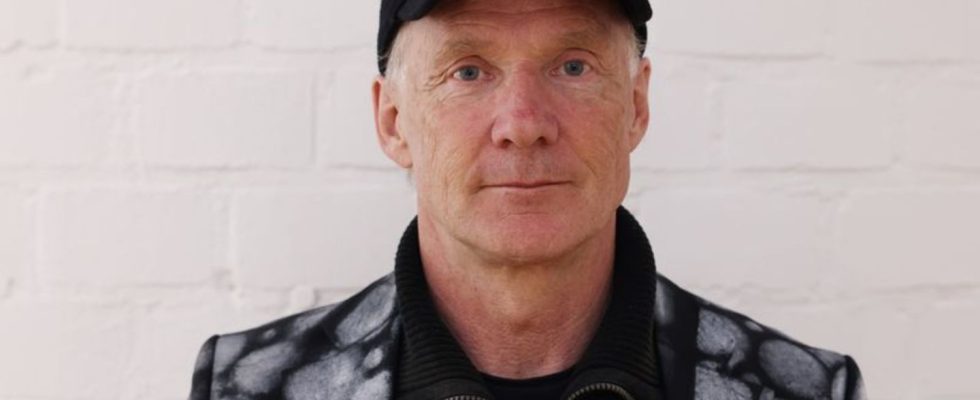Thomas Baumgärtel’s career as an artist began 40 years ago in a small-town Catholic hospital on the Lower Rhine. Even then, a banana took center stage. His graffiti bananas are now world famous.
He is still drawn to the night with his stencils and spray cans. Even increased again during the pandemic: “The streets were so beautifully empty. That was a real advantage for me,” says Thomas Baumgärtel. The 62-year-old artist has been a talking point for 40 years. A banana is at the center of his work. So he became a banana sprayer.
He illegally sprays his bananas as graffiti on very specific facades – of museums, galleries and art institutions. In the meantime, it has haunted around 4000 such houses worldwide. In the process, his spray banana went from being a nuisance to a seal of approval for good art.
It all began during Baumgärtel’s community service in 1983. In a Catholic hospital in his hometown of Rheinberg, a simple wooden cross fell from the wall. Without further ado, “Zivi” Baumgärtel nailed his breakfast banana to the cross as a replacement for the broken Jesus figure. “That caused a lot of trouble. Luckily the nuns liked me.” Baumgärtel noticed “how much effect such an action can create”.
Harald Naegeli as a role model
At that time the decision matured in him: “I want to be an artist.” His role model was Harald Naegeli, the sprayer from Zurich, who was wanted worldwide with an arrest warrant because of his illegal spraying. “What he did impressed me.” In the meantime, Baumgärtel has filed around 300 criminal charges for damage to property. “I always pay that immediately. Going to court against it only makes everything more expensive.”
In the meantime, his banana has become a kind of Michelin star in the art scene from Paris, New York to Basel – spontaneously welcomed by New York gallery owners, initially cursed by gallery owners in Germany. Perhaps because it should also be art criticism: “Not everything is art just because it’s hanging in a museum. The whole art scene is totally bananas,” says Baumgärtel. “At least that’s what I thought at the time.”
For his spray bananas, however, he chooses the houses that he likes: “That’s my way of declaring love.” When he showed up with an acquaintance at the Museum Ludwig in Cologne in the night of 1986, things went awry: “The police surrounded us with weapons drawn. They probably thought I had planted a bomb there. When it came over the radio that it was a spray banana, they got a lot more relaxed.” He still had to remove the banana from the wall.
But two years later, the museum had a new director in Siegfried Gohr, and he recognized the artistic sense behind the banana spraying. He asked Baumgärtel to spray the banana back to the museum. He was allowed to choose his position. It became a triumphal procession for the native of Cologne.
“I feel like a restaurant critic and I’ve never been paid for it. I won’t be bought.” When he came to Moscow for the first time in 1995, he was amazed: “The bananas already existed there. They sprayed them on themselves. That’s when I realized that my campaign is now known around the world.”
Promotion for the anniversary of the Cologne Cathedral
In 1998, on the occasion of the 750th anniversary of Cologne Cathedral, Baumgärtel surprised everyone with a major campaign that he had been working on for a year and a half: He had a 14 meter long and four meter high banana hoisted in front of the main portal of Cologne Cathedral, weighing four tons. “We had to set it up in five minutes so that the police and security wouldn’t get in the way.”
For more than 15 years he has been planning to push a giant banana through the Brandenburg Gate in Berlin. “I’m still in talks,” he says.
After Russia’s attack on Ukraine, Baumgärtel unfurled a ten-meter-high banner on a Cologne house facade showing the Russian ruler Vladimir Putin in convict clothing, with the play on words: “Put in prison.” “It should hang there until he’s actually in prison,” says Baumgärtel. He is not currently drawn to Moscow: “More likely to Ukraine. There are still a few museums that are excellent.”
When corona deniers and opponents of vaccination mobilized during the pandemic, Baumgärtel went out to honor health institutions such as the Hamburg Hygiene Institute – with its “vaccination banana”, which shows its banana in a modified, virus-like form.
After the failed coup attempt in Turkey, he shows Turkish President Recep Tayyip Erdogan with a banana in his buttocks. His followers lost their composure and heaped death threats on him: “That gave me police protection for a long time. The reactions were violent.”
Baumgärtel: “Art must work”
Many an addressee, whom he surprises with a banana on the facade, still quarrels with this gift. Not long ago, a long-established Cologne gallery owner shouted at him: “You asshole!” Baumgärtel takes it like an accolade. “It’s amazing that it still has such an effect after decades. Art has to work.”
As far as artistic fame is concerned, another graffiti artist has now passed him: “Banksy is great,” says Baumgärtel. “With 188 million euros, he now has the second most sales after Gerhard Richter at auctions. In comparison, street art in Germany is still ignored.”
The retrospective “40 years of banana sprayers” can be seen in Stefan Piekarski’s gallery “Art Limited” in Ratingen near Düsseldorf until May 30th. Baumgärtel’s original banana also hangs there on a wooden cross – dark brown and shriveled after 40 years. “I just took it with me back then.”

